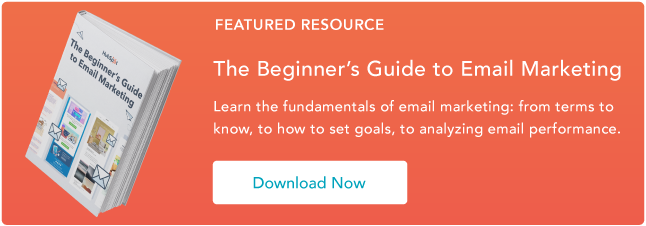For many years, Google algorithm updates have left marketers, SEOs, and business owners confused and concerned. I wonder if search engines like Google wait for you to get all of your ducks in a row, only to unleash an update that can make your efforts obsolete.
Plus, some secrecy behind how Google determines websites and their order of appearance on the search engine results page (SERPs) for different queries doesn’t help.
![→ Download Now: SEO Starter Pack [Free Kit]](https://i4lead.com/wp-content/uploads/2024/03/1d7211ac-7b1b-4405-b940-54b8acedb26e.png)
The good news is that there are several free and paid search engine optimization (SEO) tools for monitoring and auditing your site. Not only can these tools help you improve your ranking, they can help you reduce or eliminate the impacts of Google updates that may sweep through your industry.
Note: Some of the free tools below also offer paid plans, while some of the paid tools also offer free plans. We recommend you check the pricing pages for the tools that interest you to determine the ideal plan for your needs and goals.
For universal SEO tips, you can use today to grow your business, check out our video guide below.
Free SEO Tools
These tools are free to use, but you might find a paid option that has more features. We’ve shared some of the best features in each tool, as well as how you can get the most out of them for your SEO strategy.

Image Source
The goal of marketing is to generate traffic and qualified leads via the company’s website. That’s why, as marketers, we need to understand what we can do to improve the SEO of websites we manage.
I like that with HubSpot’s Website Grader, you enter your website URL and receive a report with actionable SEO insights. Here’s the result of the HubSpot website from the grader:
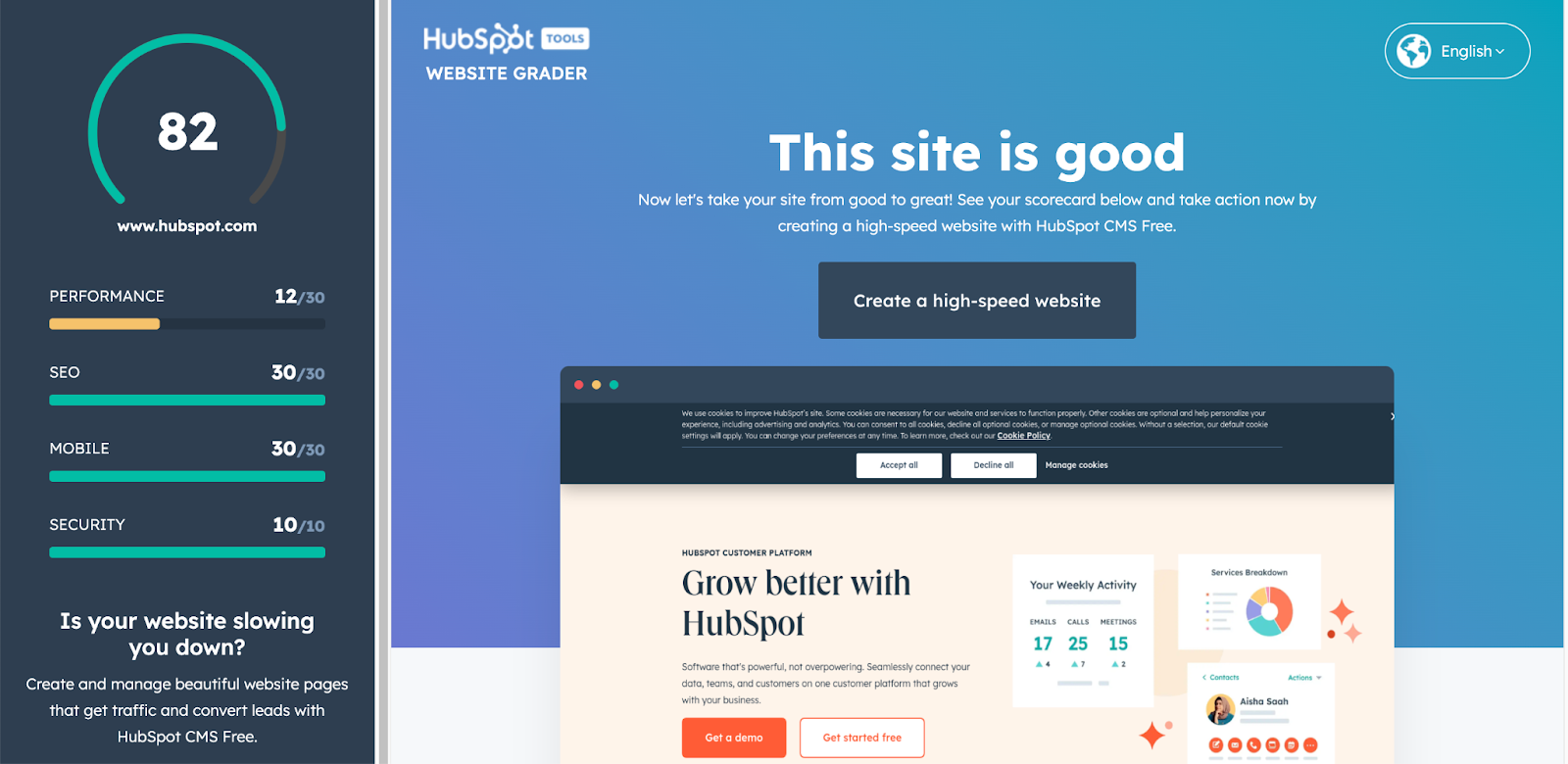
If you check your website and your report is not looking good, you can sign up for the HubSpot Academy SEO course to learn how to improve your website’s SEO, user experience (UX), and more.
With the HubSpot Website Grader, you can:
- Website performance: Learn about your website’s performance in seconds, identify specific performance issues, and receive actionable feedback on how to fix them.
- On-demand support: Receive how-to education on improving your website.
- Improve specific website issues: Gain access to a five-lesson HubSpot Academy course on Website Optimization to understand how to improve challenges with your website.
- Optimize for mobile: Discover how to optimize your website for mobile.
- Boost web security: Learn how you can implement website security best practices.
- Enhance the user experience: Personalize your website’s UX to create a delightful experience for users.

Image Source
Google Search Console has several tools available to help you appear in the SERPs for the search terms and phrases your target audience is looking for.
If you’re the owner of a business or an SEO on your marketing team, Search Console can help you conduct an initial SEO analysis from scratch or update your existing SEO strategy with fresh keywords. I like that Google Search Console monitors, debugs, and optimizes your website — and you don’t need to know how to code to benefit from this tool.
Here are some website elements Google Search Console will teach you about and help you optimize:
- Keywords: Learn about the keywords your web pages are currently ranking for.
- Crawl Errors: Identify any crawl errors that exist on your website.
- Mobile Responsiveness: Understand how mobile-friendly your website is and discover opportunities to improve the mobile experience for users.
- Google Index: See how many of your web pages are in Google’s Index (if they aren’t in Google’s index, you can use the tool’s URL Inspection Tool to submit a page for indexing).
- Analytics and Metrics: The website-related metrics that matter most to you, like clicks, impressions, average click-through rate (CTR), and average position.
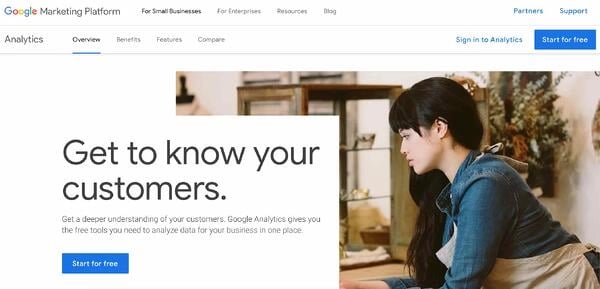
Image Source
Although Google Analytics has a paid version, the free version of the product can help you manage your website’s SEO — this is especially true if you pair Google Analytics with Google Search Console (which I recommend). In doing so, all of your website’s SEO data will be centrally located and compiled, and you can use queries to identify areas for improvement with the keywords and phrases you want your website and web pages to rank for.
Other ways that you can use the free version of Google Analytics are:
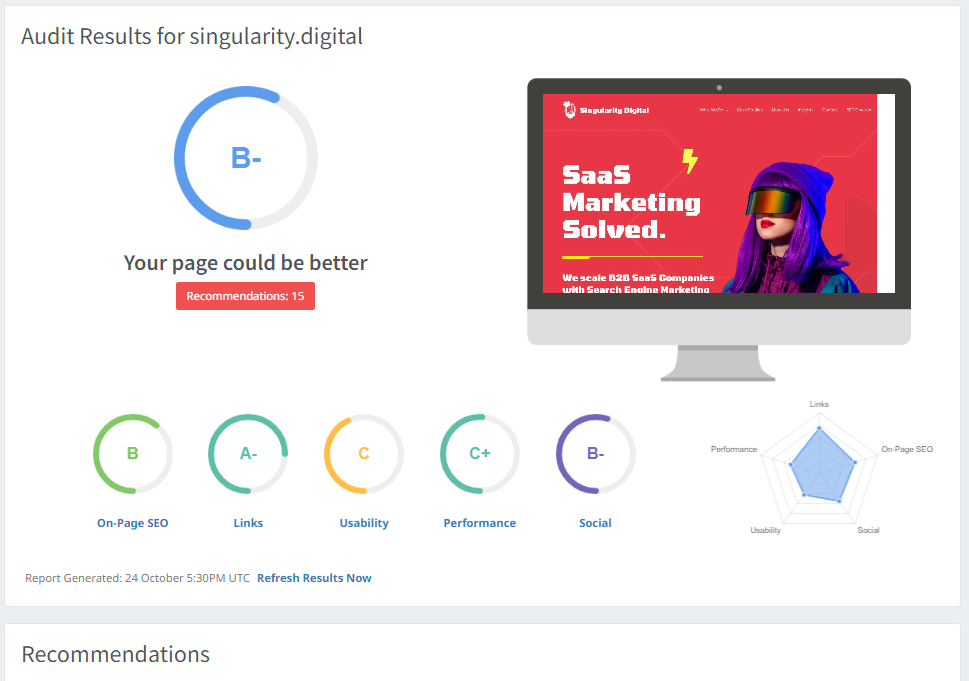
Image Source
The Free SEO Report Card by Singularity Digital lets you analyze your website to determine how it stacks up against the competition.
In exchange for your email address and a few data points, the SEO Report Card will cover:
- A website score — a score from A+ to F ranking your site’s overall SEO strength and a breakdown of it per category.
- Rank analysis — a snapshot of your website ranking across the world.
- Link building — a breakdown of the websites that link to your site and your domain link strength.
- On-site analysis — a look at how successful you were in implementing on-page SEO elements like headings and alt tags.
- Website accessibility — information about your site’s mobile usability and how it displays on different devices.
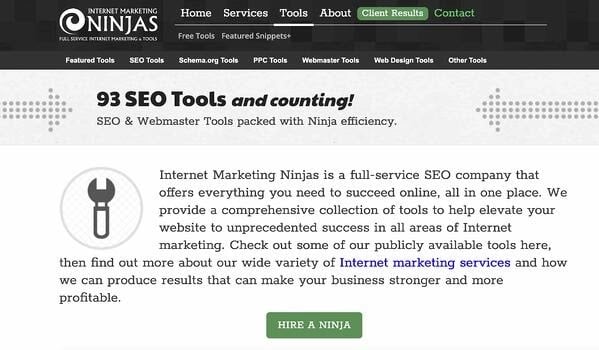
Image Source
Internet Marketing Ninjas is an SEO-focused company with a variety of free tools for comparing your website against the competition, optimizing web pages for certain keywords, generating meta tags, and increasing organic traffic to your website.
Here are some examples of the free Internet Marketing Ninja SEO tools you can take advantage of:
- Broken link tool. Identify broken links and redirects and use the site crawl feature to generate an XML sitemap of your website.
- Image metadata. See all of your page links (external, internal, etc.) on your web pages to review what’s working well and what’s broken or needs an update.
- On-page optimization tool. Use this to evaluate your web page content, meta information, and internal links.
- Side-by-side comparison. Compare the SEO of your web pages versus a competitor’s web pages.
- Page speed tool. Analyze page-load time and how long each component of a web page takes to fully display.
6. Bing Webmaster
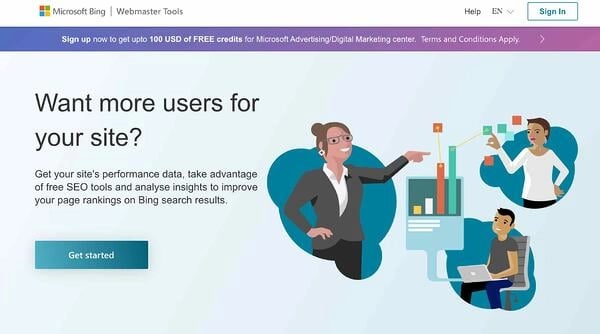
Image Source
Microsoft Bing Webmaster gives you access to many tools that offer insight into your website, such as reporting, diagnostic, and SEO tools. The SEO tools you can use for free can help you analyze your website, manage backlinks, and review keywords to ensure your site is well-optimized for organic search.
Here are other things you can do with the Bing Webmaster SEO tools:
- Seeing backlink profiles. Learn about your backlink profile to understand referring pages, domains, and anchor links.
- Performing keyword research. Determine which keywords and phrases your audience is searching for, as well as the search volumes of those keywords and phrases.
- Using the site scanning feature. Crawl your website and identify technical SEO errors.
- Getting SEO reports. Review any errors on your website and individual site pages.
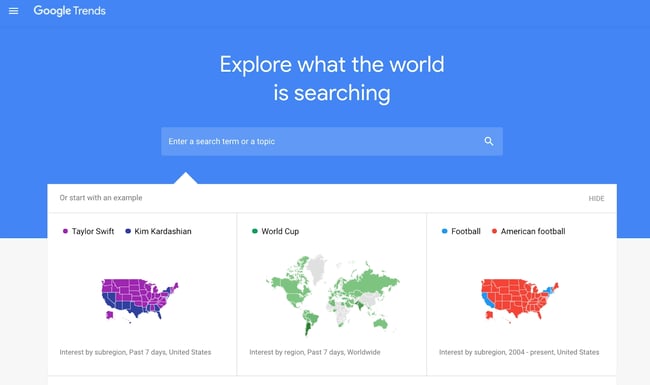
Image Source
Traditional SEO tools are great for conducting research and audits when your business is already established. But what if you’re starting a new business venture and want to know what popular industries, topics, and ideas people are exploring? Google Trends is a great place to explore the untapped potential that can yield a large keyword landscape for your website.
Note that Google Trends isn’t where you’ll get granular data. I think this tool performs best when you use it as a compass to set a direction for your SEO strategy and then pair those insights with a more robust software like HubSpot’s SEO Marketing Tool.
Here’s what you should look for in Google Trends:
- Trends: Look for trends in specific countries or regions of the world.
- Popular topics: Find popular people and long-tail keywords related to them.
- Comparisons: Compare and contrast trends over time.
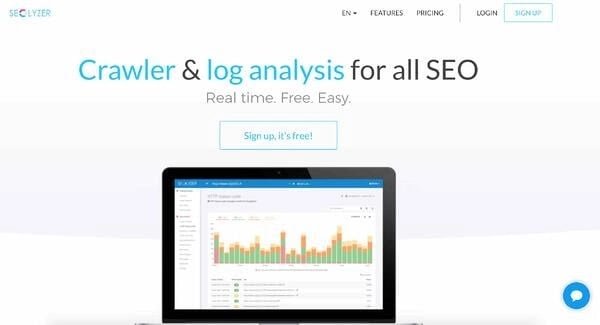
Image Source
Seolyzer is a free SEO tool for site crawling, log analysis, and determining how search engines like Google view your website. Seolyzer pulls information that crawling bots leave in your server’s log files while browsing your site. The tool also identifies error codes, redirects, and page speed performance.
Additionally, Seolyzer can help you:
- Monitor SEO issues: Identify poor response time, error messages, and crawl volume so you can resolve them before serious damage is done.
- Manage your unique KPIs: Analyze page performance, crawl volume, HTTP status codes, active and new pages, and desktop versus mobile responsiveness.
- Segment web pages: Determine what your most crawled pages are.
- Compare web pages: See what Google deems as the most important to the pages that are crucial to your business’s bottom line.
- Measure SEO impact: Understand the impact of your SEO efforts on a page-by-page basis or by the category of the page.
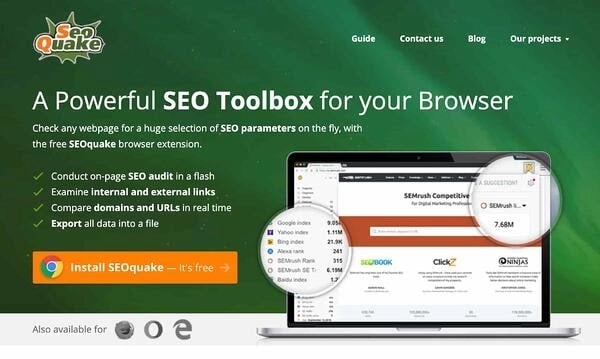
Image Source
SEOquake is a Google Chrome extension that automatically checks a web page’s SEO parameters quickly for free. This includes on-page SEO audits, internal and external link reviews, real-time URL and domain comparison, and data file export.
Other things you can use SEOquake for are:
- Link Analysis: Get a detailed description of your link performance — including URLs, anchor text, and other link types — with the tools Link Examiner feature.
- Focus on metrics that matter: Adjust your SEOquake reports to display only the parameters and metrics that you care about.
- Audit your website’s SEO: Identify any SEO-related issues that search engines can find.
- Share your findings with stakeholders: Export the results of your SEO analysis into a customizable and shareable report.

Image Source
Seobility is a free SEO-checker tool. With it, you can test your website’s level of compliance with today’s SEO guidelines. I like this tool because when you enter your URL, Seobility will analyze your site and provide some custom website optimization tips.
Besides the detailed SEO audit of your website, you’ll gain access to 1,000 subpage audits, email reporting and alerts, and keyword monitoring.
Here are some more features you can leverage when using Seobility:
- Finding technical errors: Resolve on-page SEO issues quickly to recover lost traffic and prevent future traffic dips.
- Accurate SEO scoring: Receive an SEO score that accounts for various website factors, including meta-information, page quality, link structure, and more.
- Meta information analysis. Understand the specific SEO issues with your meta information, such as meta titles/descriptions, meta tags, and invalid or incorrect domain names or page URLs.
- Optimization opportunities. Identify areas for improvement regarding your page speed and quality (related to text, duplicate content, responsive design, and alt attributes for content).
- Link structure suggestions. Understand how your page and link structure can be improved by getting data about your headers, internal links, and incorrect anchor text.
- Server error fixes. Identify specific server errors related to any redirects, HTTP headers, or CSS and Javascript files.

Image Source
Check My Links is a Google Chrome extension that ensures your links on both internal and external web pages work. For instance, if you were to search for a term on Wikipedia, Check My Links could tell you how many links that Wikipedia page has and how many of those links are broken.
I find it helpful because I can make corrections to broken links immediately (or, hopefully, before a page goes live). Check My Links is ideal for developers, content editors, and web designers, according to its creators.
Here are some more examples of what Check My Links can do:
- Identifying broken links: Check each link on your web pages and identify all invalid links.
- Auto-highlight issues: Quickly see the good links in green and the broken links in red.
- Export broken links for further analysis: Copy all of your bad links to your clipboard in one click.

Image Source
BROWSEO is an SEO browser for reviewing your website in a limited format to analyze its UX, content, and SEO. Once you input the URL, the output will hone in on your HTML so you’re able to understand the page’s structure, optimized search terms, and other SEO-related factors.
Here’s the snapshot of what we got by entering this article about SEO tips into BROWSEO:

Examples of what you can do with BROWSEO include:
- Seeing the number of words on the page: Find the sweet spot for copy length on your web pages.
- Determining the number of internal and external links on your page: This allows you to see how your linking strategy is working on each page.
- Seeing all of your meta information: Review title tags, alt text, and meta descriptions.
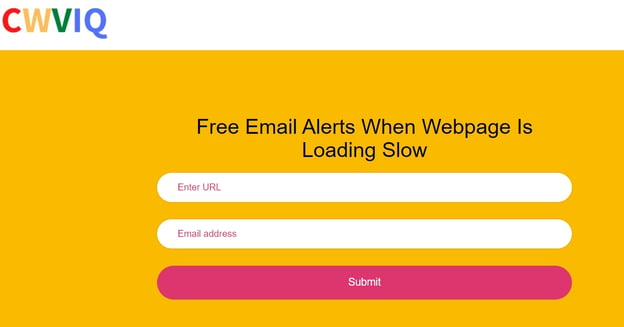
CWVIQ is a free email notification service for website owners to monitor site speed and get notified when pages load slowly.
Page speed and Core Web Vitals are essential SEO components that can impact your rankings and user experience. With CWVIQ, you can monitor these. CWVIQ also sends subscribers a weekly summary of the monitored speed through the week, along with CWV metrics.
Examples of what you can do with CWVIQ include:
- Monitoring website performance: Obtain weekly reports and analytics on page speed and web performance
- Optimize backend performance: Identify underperforming website elements to improve load times and user experience
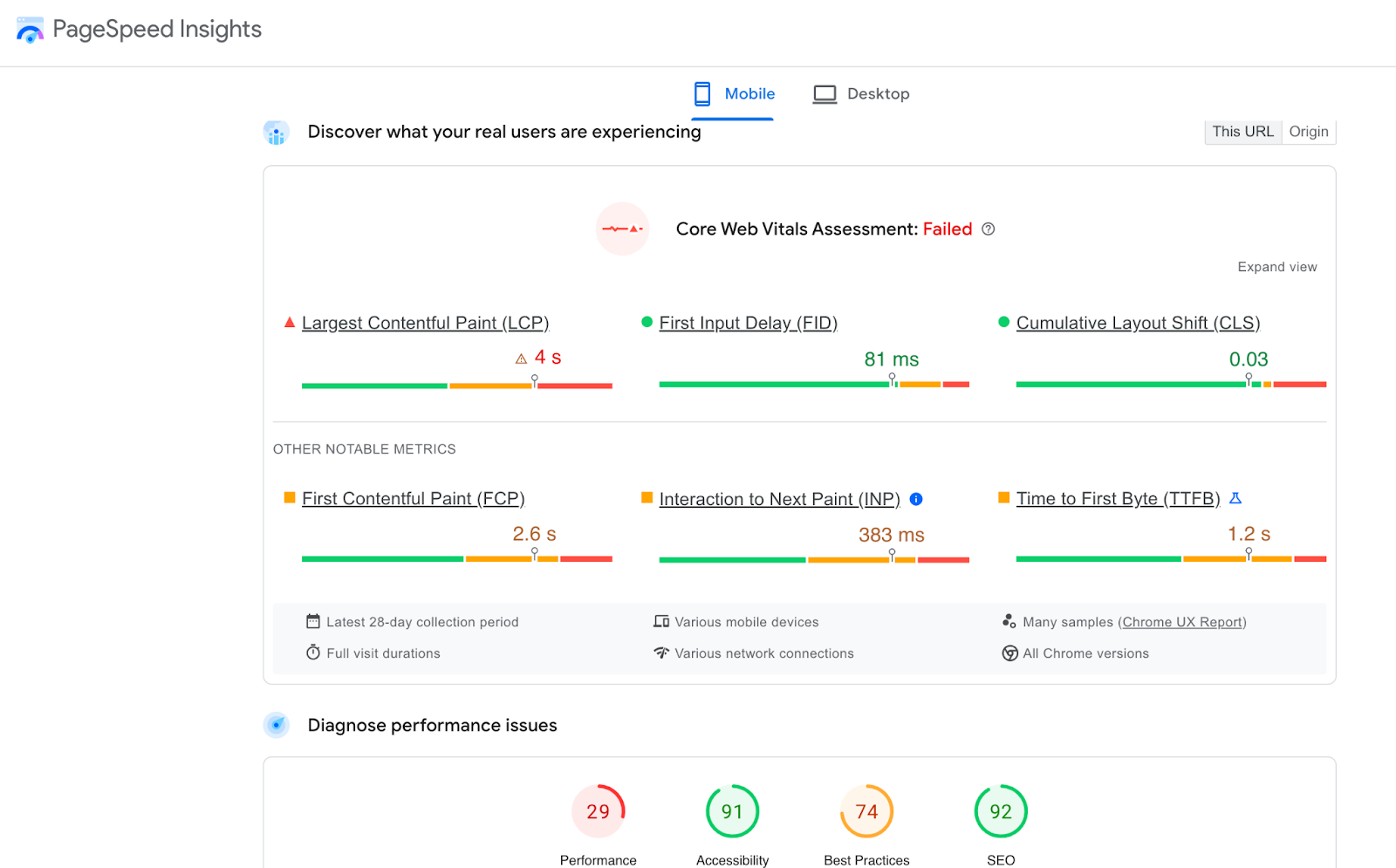
Image Source
This free SEO tool measures and reports the user experience of your website on mobile and desktop using Google’s Core Web Vitals. It also identifies problems and suggests changes you can implement to improve the page’s speed.
Here are some things PageSpeed Insights allows you to do:
- Monitoring page load speed. See how quickly the elements of your web pages load on mobile and desktop.
- Improving site navigation. Find opportunities to improve your website’s accessibility and navigation.
- Bettering UX improvement. Identify problems slowing down your website and performance. Find suggestions to create a better user experience.
- Performing UX analysis. Discover an in-depth analysis of your site’s user experience with essential metrics like:
- First contentful paint — how long it takes for a user to see content on the screen.
- First input delay — the time before a page becomes interactive and responds to the user’s first interaction, like clicking a link.
- Cumulative layout shift — how stable the page elements are as it loads.
- Largest contentful paint — How quickly the user can see the largest page element.
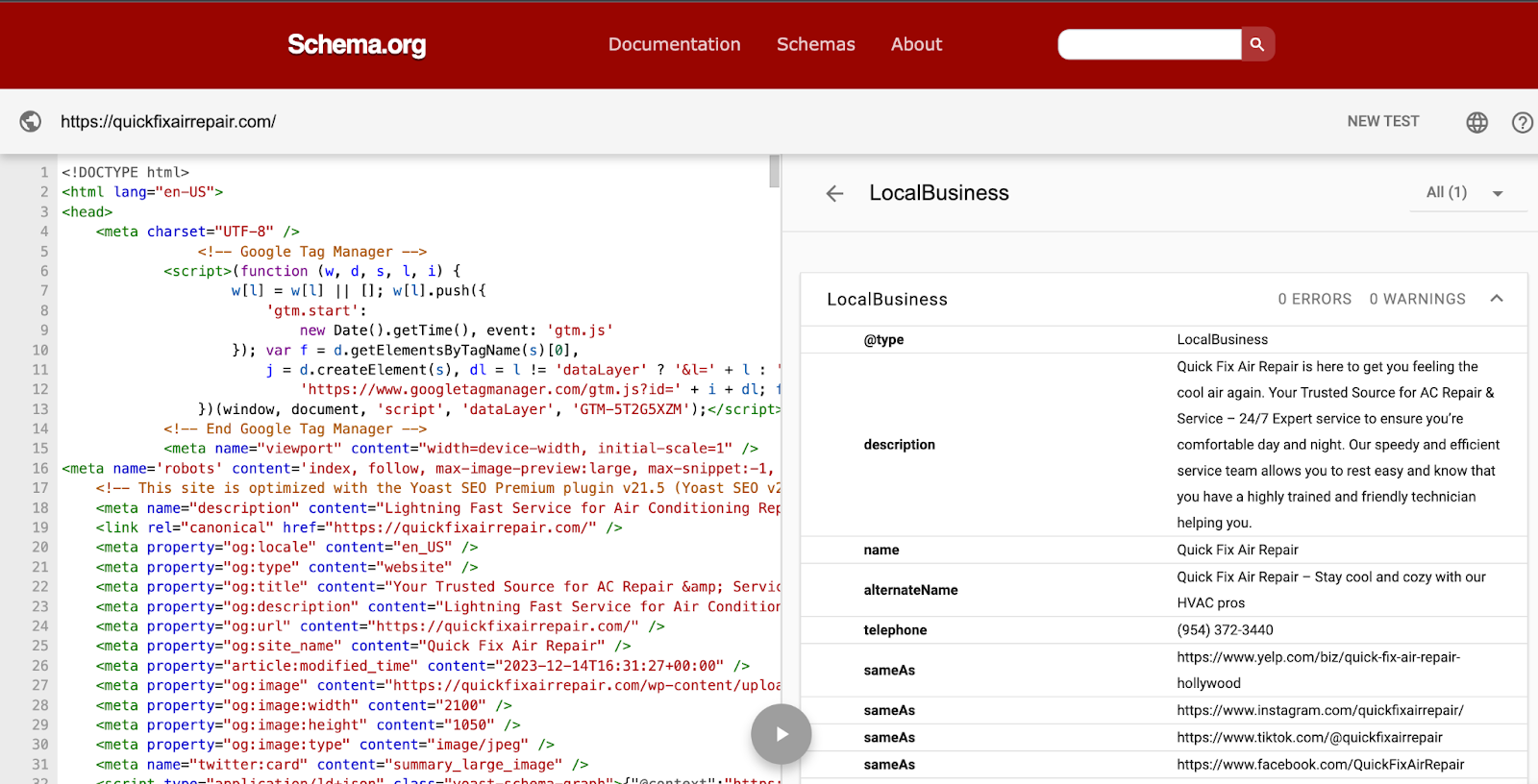
Image Source
Search bots scrape structured and unstructured data from web pages. But the bots are not always accurate.
Schema or structured data is a semantic vocabulary of tags that you can add to a page’s HTML to help crawlers understand the page’s content. Search engine companies created it as a unified language for structured website data.
This code helps search engines display your content in rich format (search results other than the traditional blue link text). For example, the recipes displayed below are rich results:
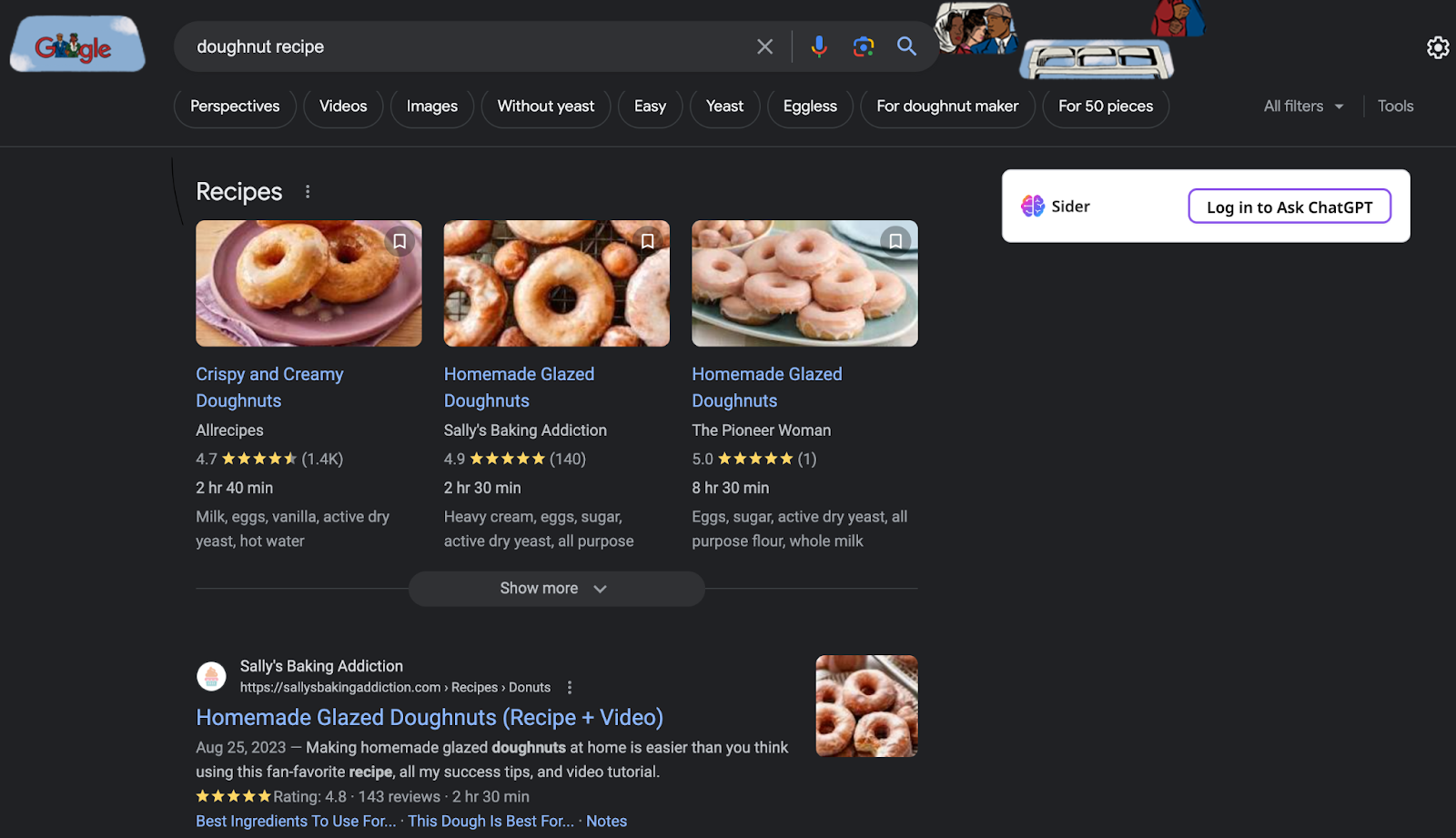
Schema data helps search engines show your pages for the right search query, increasing your website’s CTR and site visits.
Note that Google only uses 35 of the schema types. However, they don’t penalize you for including structured data they don’t use. Check out their rich results page to learn more about the schema types you can implement on your website.
Schema.org helps you to:
- Explore several ranking opportunities, including rich results like knowledge panels, FAQs, carousels, images, videos, etc.
- Add schema to any website page. Structure page data to help search engines easily find and categorize your website.
- Enhance your website’s appearance. This gives you a competitive edge in the SERPs.
Paid SEO Tools
Next, let’s look at some paid SEO tools. (Note that some of these tools have free trial periods. Some also offer entirely free plans but with restrictions in terms of flexibility and customization).
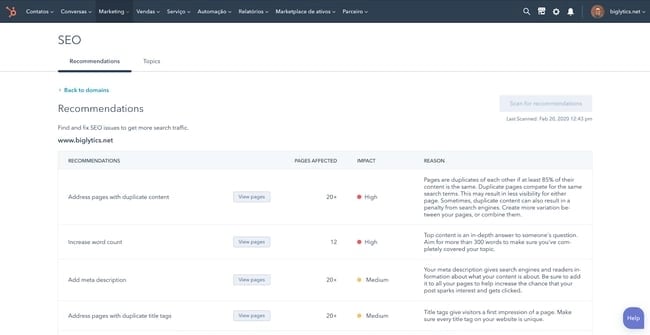
Image Source
Price: $45/ mo for the Starter plan, $800 for professional, and $3,200 for enterprise.
HubSpot’s Marketing Hub includes an SEO marketing software tool that’s perfect for helping you build authority across your website. Since this software is integrated with HubSpot landing pages, web pages, and blog posts, you’ll never miss an opportunity to optimize your content for traffic and conversions.
Whether you’re creating your first content strategy or you’re an expert in all things SEO, HubSpot’s SEO Marketing Software gives you the tools and the confidence to rank in the SERP and report on your performance.
HubSpot’s marketing software doesn’t keep SEO in a silo. This tool works in conjunction with:
- Email: Send professional emails using your own branded designs.
- Marketing Automation: Create dynamic campaigns for segmented audiences.
- Lead Management: Track leads through each stage in your sales process.
- Analytics: Review your campaign to identify success and opportunities for improvement.
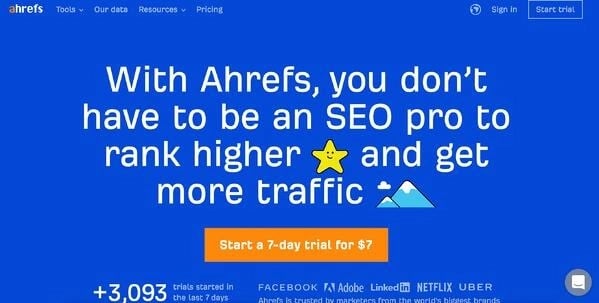
Image Source
Price: Limited free features available. Plans cost $99/mo for lite, $179/mo for standard, $399/mo for advanced, and $999/mo for enterprise.
Ahrefs is an advanced SEO resource that examines your website property and produces keyword, link, and ranking profiles to help you make better content decisions.
Some of Ahrefs’ main features are:
- A site explorer, which shows you the performance of specific web pages on your website.
- A content explorer. This allows you to search high-performing web pages under specific keywords and topics.
- A keywords explorer, which generates the monthly search volume and click-through rates of specific keywords.
- Site audits, which crawl specified verticals within your domain and reveal technical issues at the page level.

Image Source
Price: $129.95/mo for pro, $249.95/mo for guru, or $499.95/mo for business.
Semrush is an elaborate dashboard that reports on the performance of domains as a whole and their specific pages. Semrush offers numerous resources, one of which is the SEO Toolkit.
I like Toolkit because it allows you to track a website’s visibility improvement over time as well as identify which keywords it’s ranking for, what the page’s rank is for a keyword, the keyword’s monthly search volume, and more.
SEMrush also allows you to:
- Build links. Analyze backlinks from other websites to your site.
- Use the Keyword Magic tool. Identify all keywords you need to successfully build an SEO strategy.
- See your competitors’ strategies. Identify the paid keywords or ad copy used in your competition’s PPC ads.
- Receive recommendations. See how you can increase your organic traffic by optimizing your content.
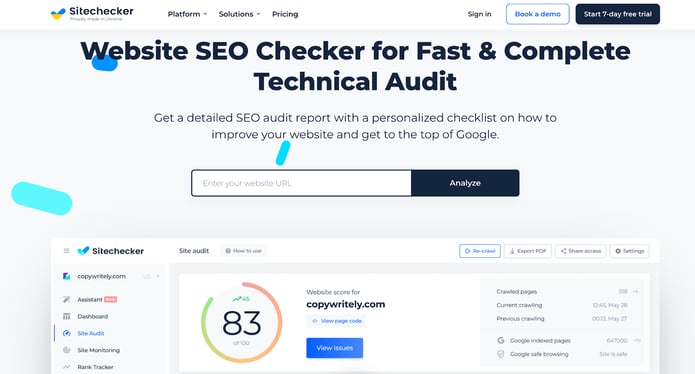
Image Source
Price: a 7-day free trial is available. Plans cost $49/mo for basic; $199/mo for standard, and $399/mo for premium.
Sitechecker is a comprehensive solution for SEO auditing that identifies opportunities to increase organic search traffic. Sitechecker is used to automatically monitor your website performance, inform you of timely error detection, and search for growth points.
Some of the top features Sitechecker offers include:
- Site audits. Track all types of errors on the site at a rate of 150 pages per minute. Fine-tuning is available to monitor website function with automatic notification when problems are detected.
- Rank tracking. Track positions of keywords for specific queries in any search network of choice, on any devices, and in a given region. Convenient service with the results and daily reports sent to your email.
- Backlink tracking. Keep track of backlink changes around the clock to avoid losing any valuable links. Control and decide which links to collect and track.
- An all-in-one Chrome Extension. Instantly check the keyword and SERP positions within your browser.
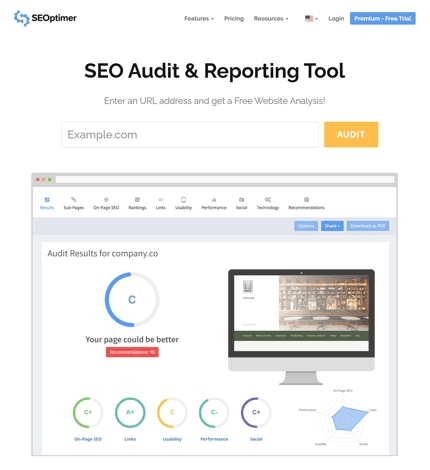 Image Source
Image Source
Price: A free trial is available. Plans cost $19 a month for DIY SEO, $29 a month for white labeling, and $59/month for white labeling and embedding.
SEOptimer is an SEO audit and reporting tool used by digital agencies to create white-label audits and embed an audit form on their website for lead generation. SEOptimer’s reports are comprehensive and check over 70 data points.I like that you can run free site audits right from their homepage. An overall score is applied for the site, and additional scores are broken down into five categories: On-page SEO, Backlinks, Usability, Performance, and Social media (including Local SEO). The report contains details about each check and indicates a pass/fail, together with recommendations on how to improve.
Some of the top features SEOptimer offers include:
- Unlimited white label audits. Create customized, white-labeled SEO audits.
- Embeddable audit tool. Fully customize and embed a site audit form into your agency website to generate new leads.
- An SEO crawler. Scans every page of a site for problems and identifies issues holding back a site from ranking.
- A keyword research tool. Perform keyword research quickly, see search volume, competition, traffic, and CPC.
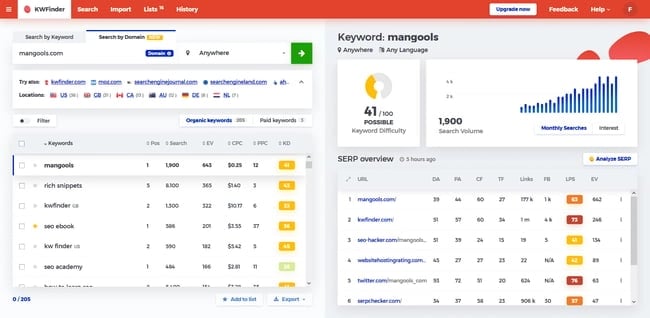
Image Source
Price: A free trial is available. Plans cost $29 a month for entry, $49 a month for basic, $69 a month for premium, and $129 a month for agency.
Sometimes, you don’t need an SEO tool with all the bells and whistles if you only need to do keyword research. I think KWFinder is a great software that fills the gap between nuts-and-bolts SEO work and copywriting. You’ll find keywords that aren’t too difficult to rank for but still carry the potential to bring in traffic.
What makes KWFinder unique is how seamlessly it shifts between languages and regions so that you can serve your audience no matter where in the world they are.
Some of the top features KWFinder offers include:
- Hidden long-tail keyword insights. Find long-tail keywords that give you more opportunities to acquire traffic.
- Competitor keyword insights. See how your competitors’ keyword strategy compares to your own, plus find more keyword opportunities.
- A SERP analysis tool. Analyze competition in the SERP to understand what elements readers are looking for on your pages.
- A local keyword research tool. See what searchers are looking for locally and appeal to local markets for more niche traffic.
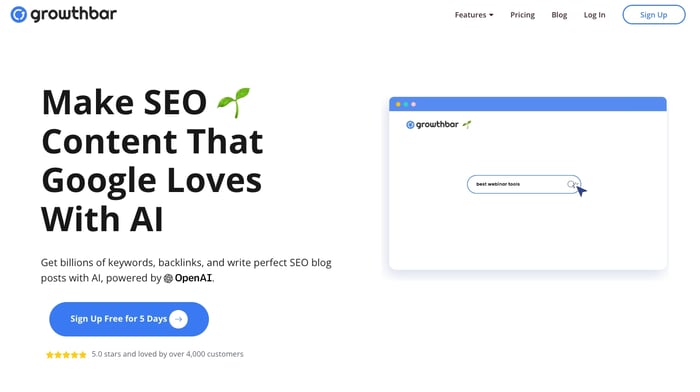
Image Source
Price: A free 7-day trial is available. Plans cost $36 a month for standard, $74.25 a month for pro, and $149.25 a month for agency.
GrowthBar is an AI tool and SEO auditing tool for performing keyword research, writing, doing competitive analysis, and tracking SEO rankings. With the GrowthBar Chrome extension, you can access data about any website directly from the SERPs.
This allows you to evaluate your competitors’ performance and view the growth channels, keywords, backlinks, and ads that are working for them.
Here are some more key features of GrowthBar:
- Top keywords and backlinks. See which paid and organic keywords are driving the most traffic for your website and get a list of the most authoritative backlinks pointing to your site.
- Get your keyword difficulty score. Quickly assess the difficulty of ranking a keyword based on the strength of the domain authorities of the URLs ranking on page one.
- Use the word count tool. View the word count of any page directly from the SERP.
- Use the keyword suggestions tool. Get a list of related keywords you might want to rank for, along with their search volume and cost per click.

Image Source
Price: A free 3-day trial is available. Plans cost $89.99 a month for pro and $199.99 a month for premium. Contact Woorank for an enterprise quote.
Woorank’s in-depth site analysis helps marketers reveal opportunities for optimization and improvement. This analysis takes into account the performance of existing SEO initiatives, social media, usability, and more.
Each report is divided into sections to help you easily analyze your site and identify targets for optimization. Here are a few features of the report:
- Marketing checklist. Review common marketing tasks that you can complete as part of your SEO strategy execution.
- SEO. Analyze your SEO metrics against your goals.
- Mobile optimization. Decide which mobile optimization tactics to employ based on the mobile data.
- Social analysis. Get insight into how social media is playing a part in your traffic and SEO goals.

Image Source
Price: Free 30-day trial, $24/ mo for Starter, $124/ mo for Group, $299/ mo for Professional, $999+ for Custom
Price: A free 14-day trial is available. Plans cost $24 a month for starter, $124 a month for group, $299 a month for professional, and $999+ for custom.
Backlinks are crucial for getting your website to rank well on Google. However, the outreach process is daunting and can feel a lot like cold calling. With BuzzStream, you can easily research the appropriate people, come up with effective email messages, and track who’s accepted each link request.
BuzzStream also helps you:
- Identify candidates for outreach. Find them based on their industry and how engaged they are across various social networks.
- Identify candidates for backlinks. These are individuals who will likely be receptive to your backlink request for other reasons that are unique to your business’s niche.

Image Source
Price: Free 30-day trial, $99/ mo for Standard, $149/ mo for Medium, $249/ mo for Large, $599/ mo for Premium
Price: A free 30-day trial is available. Plans cost $79 a month for standard, $143 a month for medium, $239 a month for large, and $479 a month for premium.
The Moz Pro subscription serves as an all-in-one tool for increasing your website search ranking. Moz’s collection of research tools provides subscribers with the resources they need to identify SEO opportunities, track growth, build reports, and optimize their efforts.
Moz Pro also includes:
- A website crawler, which analyzes up to 3,000 links on a given URL.
- Email reports, which detail the crawl data for the pages your site links to.
- Insight into various “crawlability” factors. These include duplicate content and redirects that could be influencing your SEO performance.

Image Source
Price: A 30-day free trial is available. Plans cost $14.90 a month for webmaster, $24.90 a month for advanced, $49.90 a month for pro, $99.90 a month for agency, and $153.90 a month for agency XL.
The best way to understand the performance of your off-page SEO is by having a good overview of your backlinks. Linkody allows you to discover, track, analyze, and disavow backlinks, all from an easy-to-use interface.
Aside from that, the tool checks your links 24/7 and informs you of any changes so you can take immediate action in case a link is lost or broken.
Other Linkody features include:
- A way to “Spy” on your competitors’ backlinks. Enter the URL of your competitor and let the tool pull all the links and metrics. The information returned will help you discover niche-relevant, high-quality backlink opportunities for your brand.
- Methods to gain useful insights. See your most important metrics when it comes to backlink tracking, such as the ‘rel’ attribute, Google indexation status, the website’s Domain Authority, Spam Score, Alexa rank, and more.
- The means to create white-label reports. Download reports you can share with your team and/or clients to get a better idea of your backlink distribution and link-building progress.

Image Source
Price: Free plans are available. Paid plans cost $259 a year.
Designed specifically for the SEO-minded, this program crawls the websites you specify, examining the URLs for common SEO issues. This program simplifies and expedites an otherwise time-consuming process — especially for larger websites. (It could take hours or days to manually evaluate the same URLs.)
Other notable features of Screaming Frog SEO Spider are:
- A Java program. Screaming Frog includes an intuitive Java program with easy-to-navigate tabs.
- Easy export to Excel, so you can further analyze your SEO data.
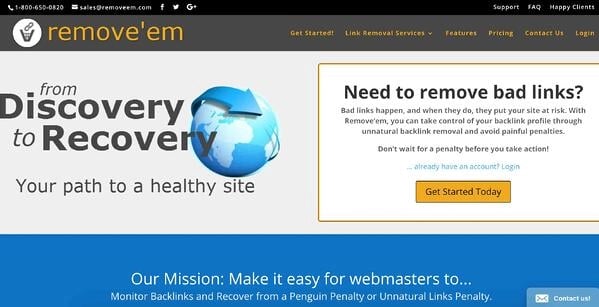
Image Source
Price: You can pay a one-time fee of $249 for the lifetime plan. A one-website subscription costs $99 a month. A 10+ website agency plan costs $899 a month.
If you’re buying a website domain that has been used in the past, or you’re rebuilding a poor SEO strategy, you may discover some problematic backlinks while conducting your audit. Artificial or unnatural links have the potential to seriously hurt your search ranking. Remove’em helps get rid of those links.
This tool can:
- Scan your backlink profile. Discover a list of contact information for the links and domains you’ll need to reach out to for removal.
- Export a list of backlinks. If you wish, you can disavow backlinks by telling Google not to take these “bad” links into account when crawling your site.
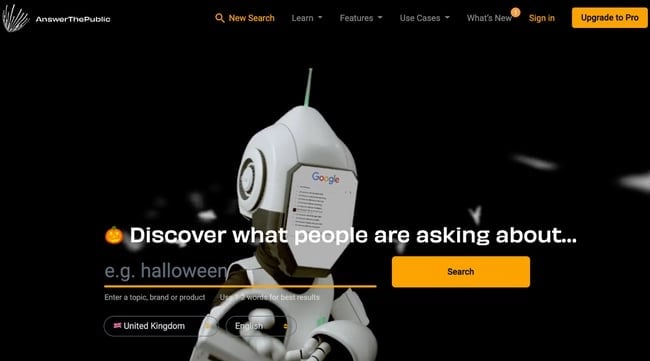
Image Source
Price: Plans cost $9 a month for individuals, or $99 a month when billed annually. Expert plans cost $199 a month.
AnswerThePublic is a search listening and keyword tool that gets autocomplete data from Google and other search engines. Entering a keyword into this tool gives you a list of phrases and questions people are searching for around your keyword.
With AnswerThePublic, you can also:
- Receive updates. See when people are talking about your most relevant keywords.
- Monitor keyword trends. Understand keyword research behavior among your target audience and customers.
- See real-time searches. View the keywords and phrases your audience is researching in real time.
- Get ideas for your website and blog. Discover new content ideas based on relevant keyword research.
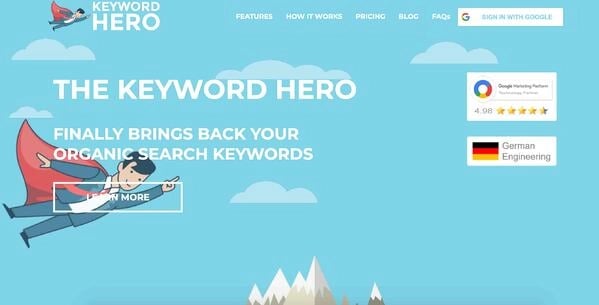
Image Source
Price: A 14-day trial of any plan is available. The little hero plan is free. Plans cost $9 a month for big hero, $49 a month for giant hero, and $149 a month for ultimate hero.
Keyword Hero pairs your visitors’ sessions with the keywords they used to land on your page, all within your Google Analytics account. In other words, this tool lets you understand the search intent of your organic traffic.
Here are some more actions I love that you can take with Keyword Hero:
- Identify organic traffic and conversions. Uncover the success you receive from your intended keywords.
- Separate traffic. Identify brand versus non-brand search traffic.
- Optimize your position in the SERPs. Optimize your website for specific target keywords.
- See query details. Understand whether your visitors used informational versus transactional queries to find your website.
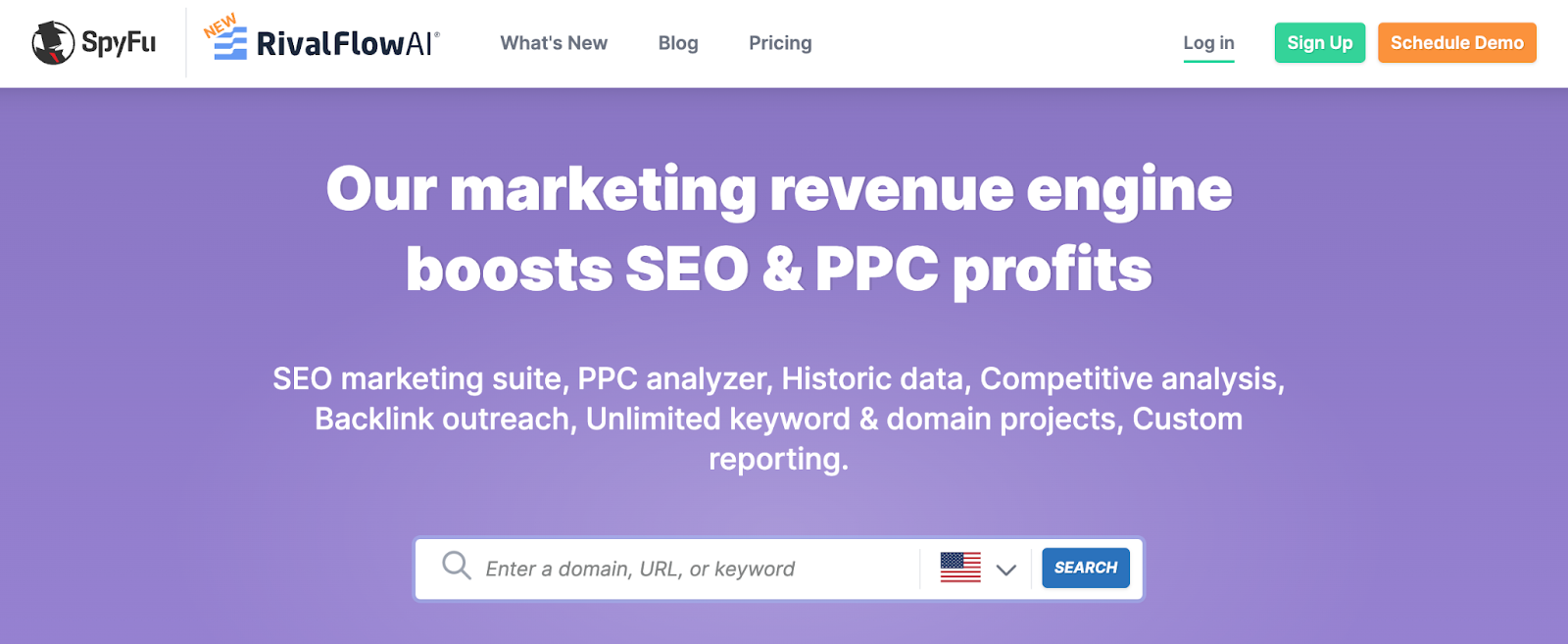
Image Source
Price: Plans cost $39 a month for basic and $79 a month for professional.
SpyFu is a competitor keyword research tool for Google Ads. In addition to keyword research, it helps with PPC competitive research, SEO competitive research, and the creation of custom lists and domains.
The tool helps you drive traffic to your Google Ads campaigns and website, monitor both paid and organic rankings on Google, Bing, and Yahoo, and obtain reliable and accurate contact information for leads.
With SpyFu, you can also:
- Download a competitor’s PPC keywords. Use this insight to develop more competitive PPC strategies that can compete in the ad space.
- Download a competitor’s SEO keywords. Use this insight to develop more competitive organic keyword strategies that can compete in the SERP.
- Review ranking trends. Access the ranking of a page or website for a keyword over time.
- Discover keyword ideas. Get keyword insights for your Google Ads to increase your chances of conversion.
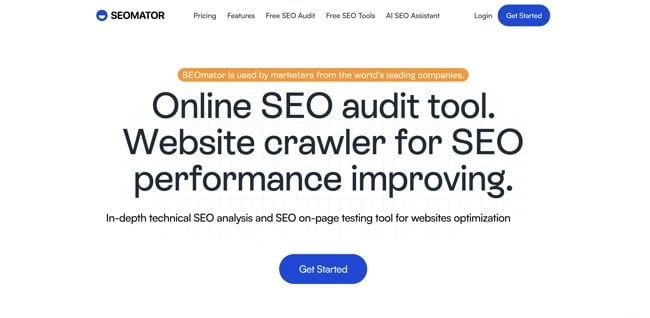
Image Source
Price: A free 7-day trial is available. Plans cost $49 a month for lite, $99 a month for standard, and $279 a month for advanced.
Seomator is an SEO auditing and website crawling tool. It assists with technical SEO analysis and on-page optimization testing.
Once the tool crawls your site, you’ll receive an SEO report that explains your website’s SEO-related elements including internal and external links, backlinks, page quality and speed, social media, organic presence, and more.
I especially like that your analysis comes with tips for improving each SEO element.
In addition, you can:
- Use the SEO monitoring alerts feature. Your website will be automatically crawled, and you’ll get an immediate notification if something is problematic in terms of SEO.
- Get detailed reports. Find insights about your on-page and off-page SEO elements.
- Use the domain comparison tool. Compare two competitors’ websites to identify the strengths and weaknesses of their SEO (such as broken links, content quality, HTML tags, and more).
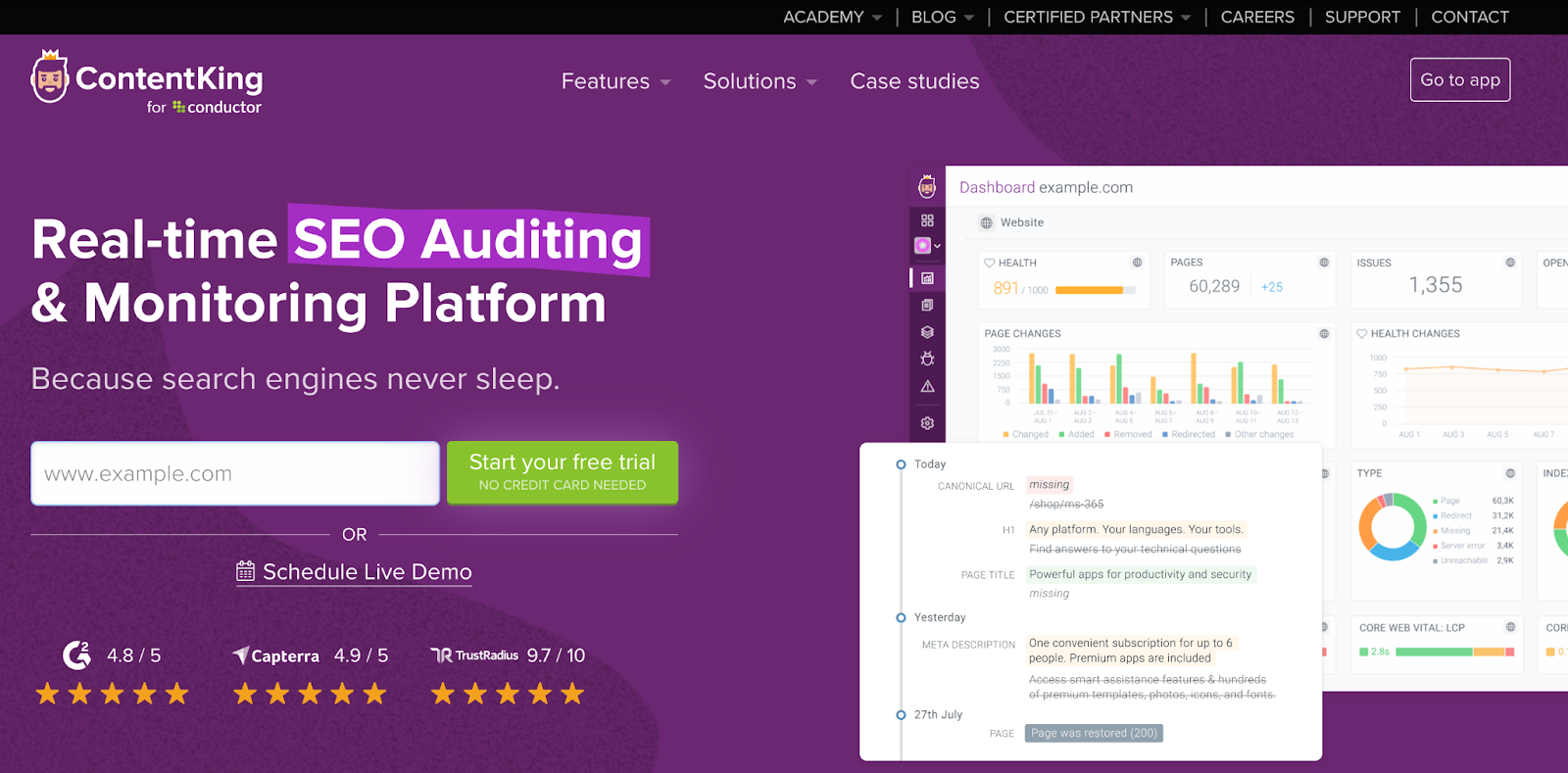
Image Source
Price: Plans cost $139 a month for basic, $319 a month for standard, $449 a month for pro, and $1,279 a month for enterprise.
ContentKing is a real-time SEO auditing and content tracking tool — it tracks your website 24/7, so any issues related to SEO don’t go unnoticed for too long. I like that the tool is cloud-based, meaning there’s no installation required, and your data and reports are available whenever you need them.
With ContentKing, you can also:
- Improve your SEO. Use ContentKing’s 24/7 website audits (and algorithms) to gain insight into your SEO and receive tasks for optimizing your web pages.
- Get alerts. Get notified whenever something on your website is broken or is no longer well-optimized so you can efficiently fix the issue.
- Track changes. Follow the history of all your content changes on your site (such as changes on individual web pages and changes in robots.txt) and search the history of your changes.
- Visualize data. See real-time dashboards and reports.
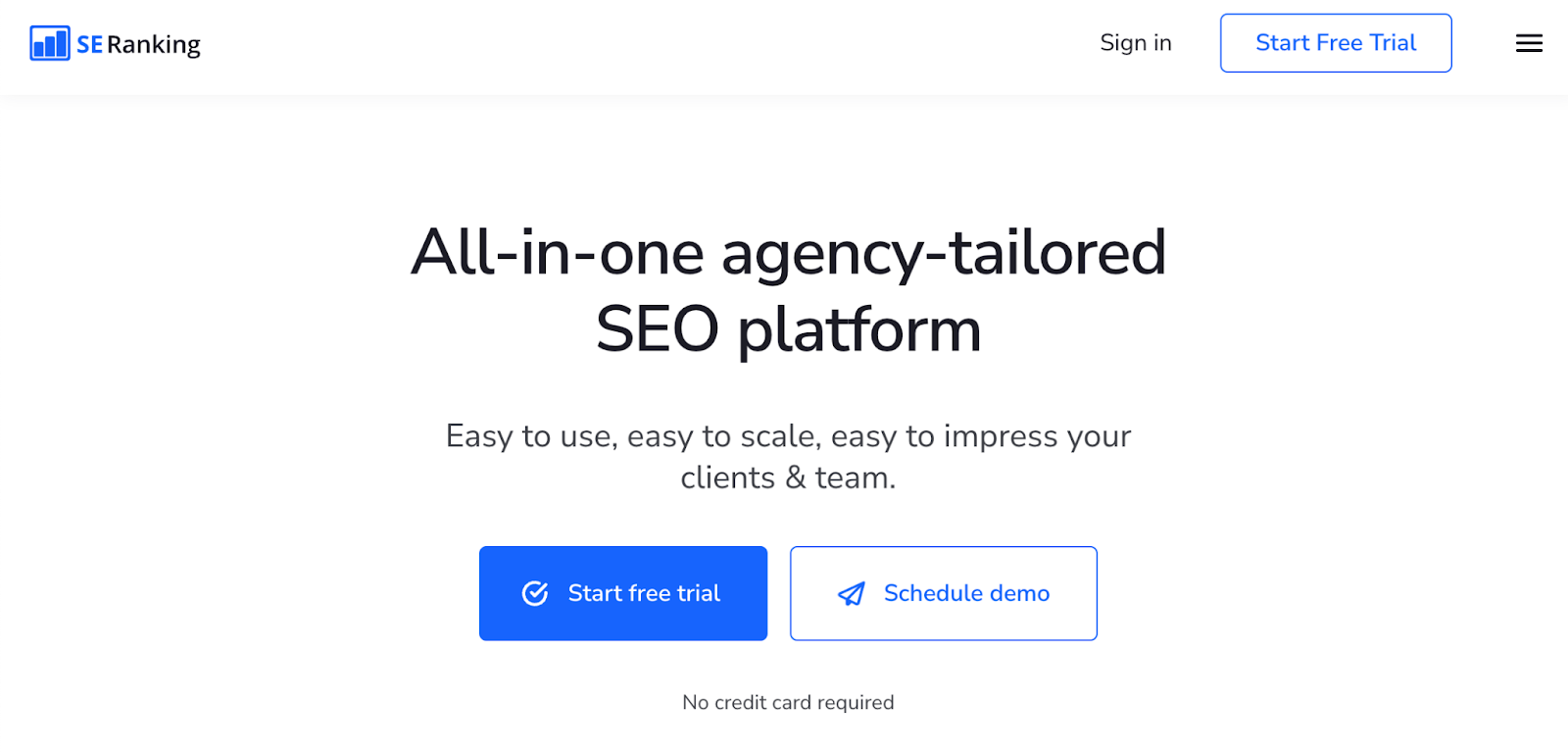 Image Source
Image Source
Price: Plans cost $44 a month for essential, $87.20 a month for pro, and $191.20 a month for business.
SE Ranking is an all-in-one SEO platform that analyzes website health and performance keyword rankings and traffic. It also provides insights into your competitors, allowing you to better understand the SEO landscape and adjust your marketing strategy.
Since SE Ranking is a white-label SEO tool, you can build custom SEO reports with branding and personalization options.
With SE Ranking, you can also:
- Perform keyword rank checks. Monitor your and your competitors’ keyword positions and provide accurate keyword rank analysis, evaluate SEO potential, and show historical data changes.
- Conduct website health audit. Evaluate all your website pages to create an in-depth report of website tech and performance errors with actionable tips on how to resolve them.
- Complete competitor analyses. Scope your competitors’ website traffic dynamics, keyword rankings, and other data in organic and paid searches.
-
Conduct backlinks analyses. Analyze any website and create a complete report of the backlink profile with dynamics of new and lost site links and referring domains, anchor text distribution, and pages linked out to the most.
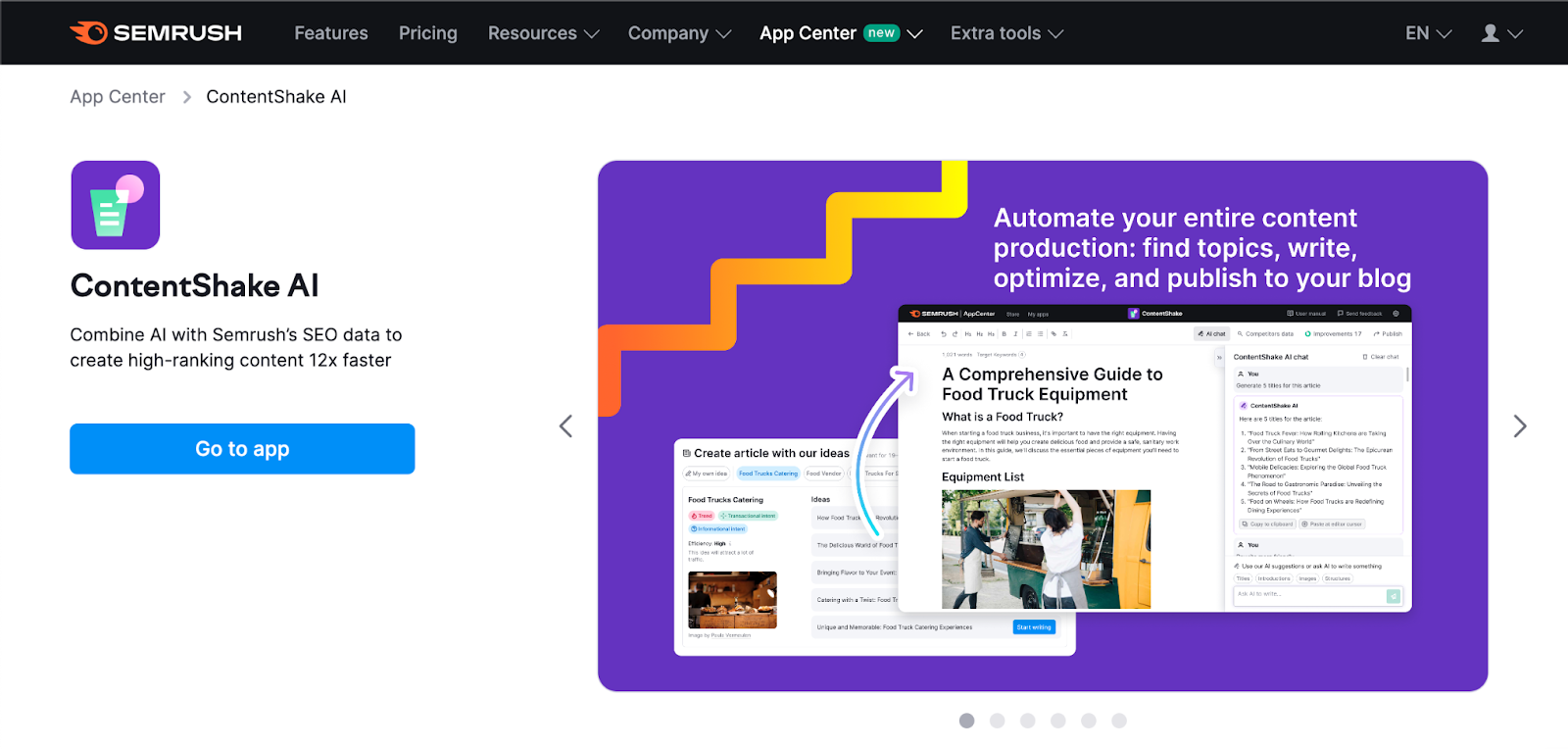
Image Source
Price: Free plans are available. A paid plan costs $60 a month.
ContentShake AI is a Semrush app with ChatGPT-like natural language processing (NLP) and SEO features. It enables you to produce search-optimized article drafts. The AI tool automates content creation from ideation to optimization and publishing.
I love ContentShake AI because it helps you with content creation by generating niche-based or general content ideas, and it allows you to create, edit, and publish SEO articles to your WordPress site. It also simplifies sentences and rephrases sections to your satisfaction and assesses your content’s readability and tone of voice.
Here are some ContentShake AI features that you can take advantage of:
- Title. Find topics suggested by AI and used by your competitors.
- Keywords. Assess the keyword efficiency, monthly search volume, and keyword difficulty of the keywords you want to rank for.
- Introduction. Choose from several introductions and customize them to fit your target audience.
- Structure. Discover keyword-optimized H2s and H3s.
- Images. Select images from Unsplash and see photos from competing websites.
- Facts and data. Select relevant data from top research platforms.
- Articles for inspiration. Glean ideas from suggested articles.
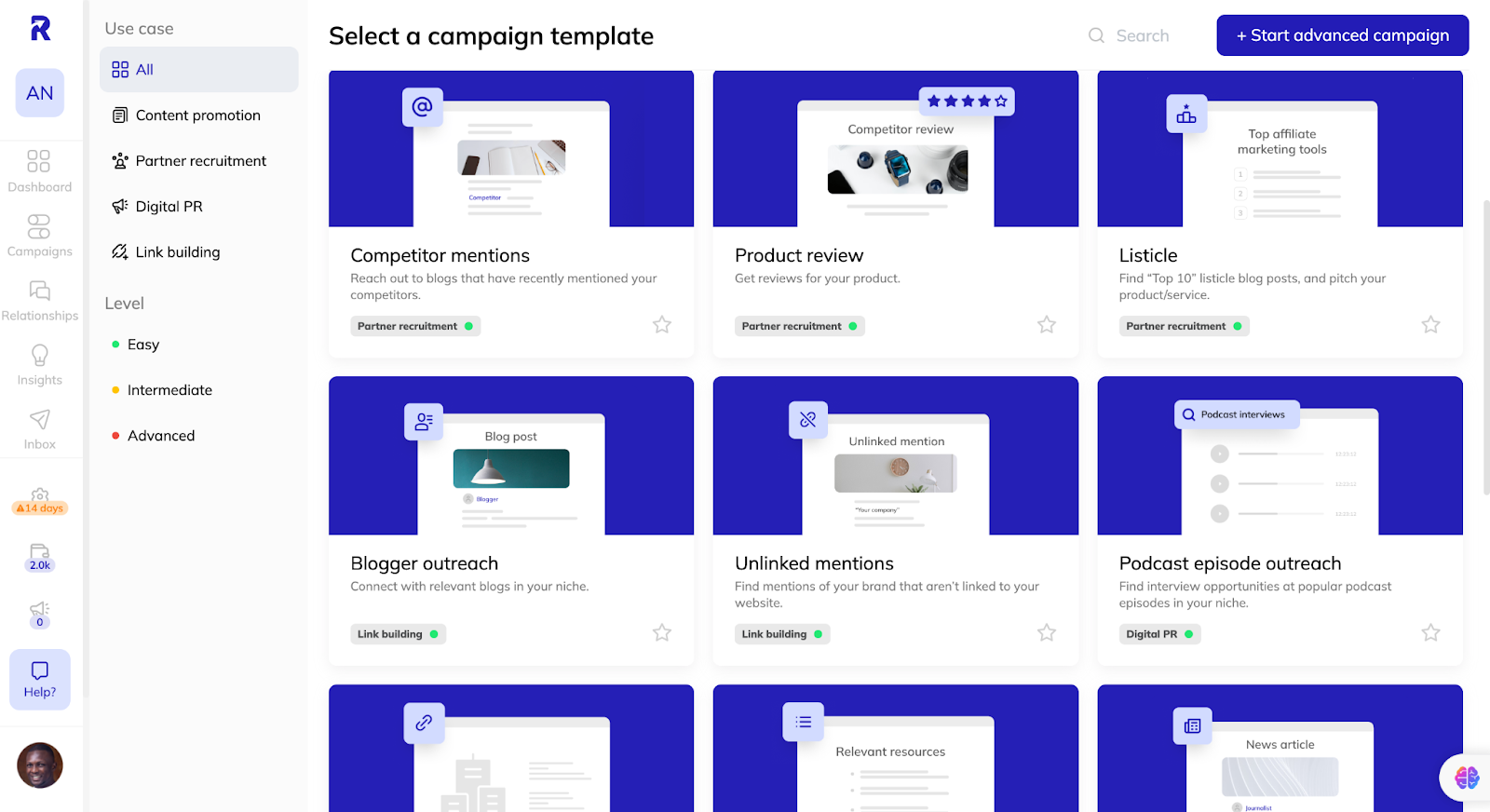
Image Source
Price: Plans cost $79 a month for starter and $399 a month for pro. Custom quotes are available for unlimited plans.
Respona is a link-building platform for building personalized outreach campaigns. This SEO tool lets you find quality link-building opportunities, get stakeholders’ contacts, send custom emails, and build recurring outreach campaigns.
Respona can help you:
- Find outreach contacts. Automatically find the perfect contact for your outreach campaigns, including their email and LinkedIn profile.
- Implement the Skyscraper Technique. Get contextual backlinks from articles linking to competitors’ pages ranking for relevant target keywords.
- Find unlinked mentions. Find pages that mention your website and nudge them to link back to you.
- Book podcast interviews. Boost your online visibility by sharing ideas on popular industry podcasts.
- Recruit affiliates. Invite publications to join your affiliate program to generate leads and increase revenue.
- Pitch resources. Pitch resources to websites listing top resources in your vertical.
- Boost your domain authority. Build quality backlinks to increase your domain ranking and visibility.
- Customize outreach templates. Personalize and automate email outreach templates for different content types.
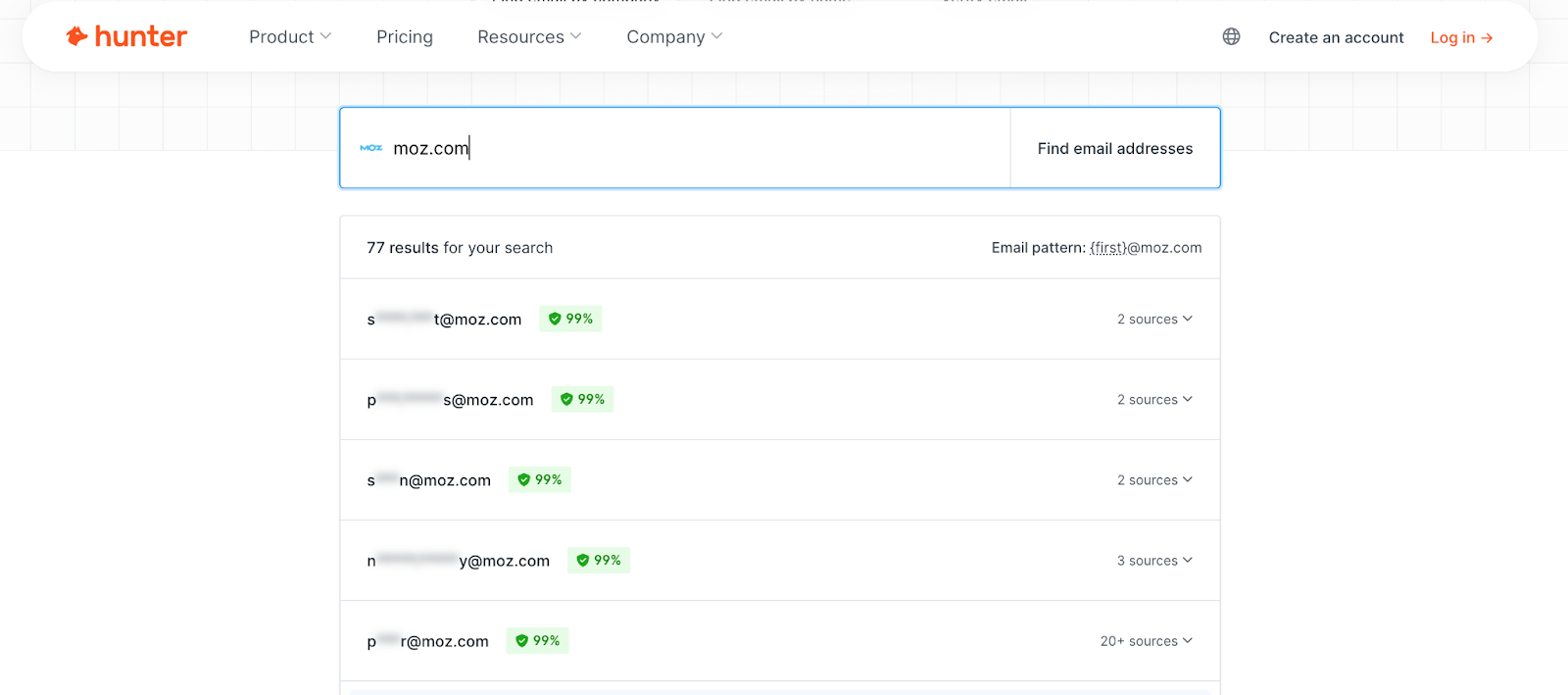
Image Source
Price: Free plans are available. Plans cost $49 a month for starter, $149 a month for growth, and $499 a month for business.
Successful link-building depends on effective outreach efforts. But how do you ensure you are reaching the right people? Enter Hunter.io.
With over 107 million indexed emails, Hunter.io is a powerful lead generation and link-building software that aggregates and verifies emails of professionals across several industries.
As a link-building tool, it gives access to personal and domain-specific emails. The transparency about the email sources and compliance with data regulations are also great.
Here are some core features of Hunter you can use:
- Email discovery. Discover all emails associated with any domain you visit online, letting you connect with article publishers to request backlinks.
- Email verification. Verify the authenticity of the prospect’s emails to avoid hit-and-miss outreach campaigns.
- Lead generation. Generate leads from different industries using filters like portfolios.
- Domain-based email search. See the emails associated with website domains you visit.
- Campaign templates. Create email campaigns by customizing templates in Hunter.io.

Image Source
Price: Free plans are available. Paid plans cost $39 a month.
If you run a local service business, you’d want to track keywords your website ranks for in specific locations. This is where Nightwatch shines.
Nightwatch is a powerful SEO tool for tracking local and global keyword ranking. This tool monitors backlinks, finds local and global keyword opportunities, and helps with competitor keyword analysis.
Nightwatch features include:
- Global and local keyword tracking. Track your website’s local ranking for specific keywords across over 107,000 locations.
- Competitor analysis. Compare your ranking for keywords with your competitors’ ranking.
- Keyword opportunities. Discover keywords to target and potentially rank for.
- Local SEO. Optimize your website to rank for specific locations.
- Site audits. Conduct site audits to spot problematic pages and assess the site’s health and security.
- Page speed monitoring. Monitor the load time of your website’s pages.
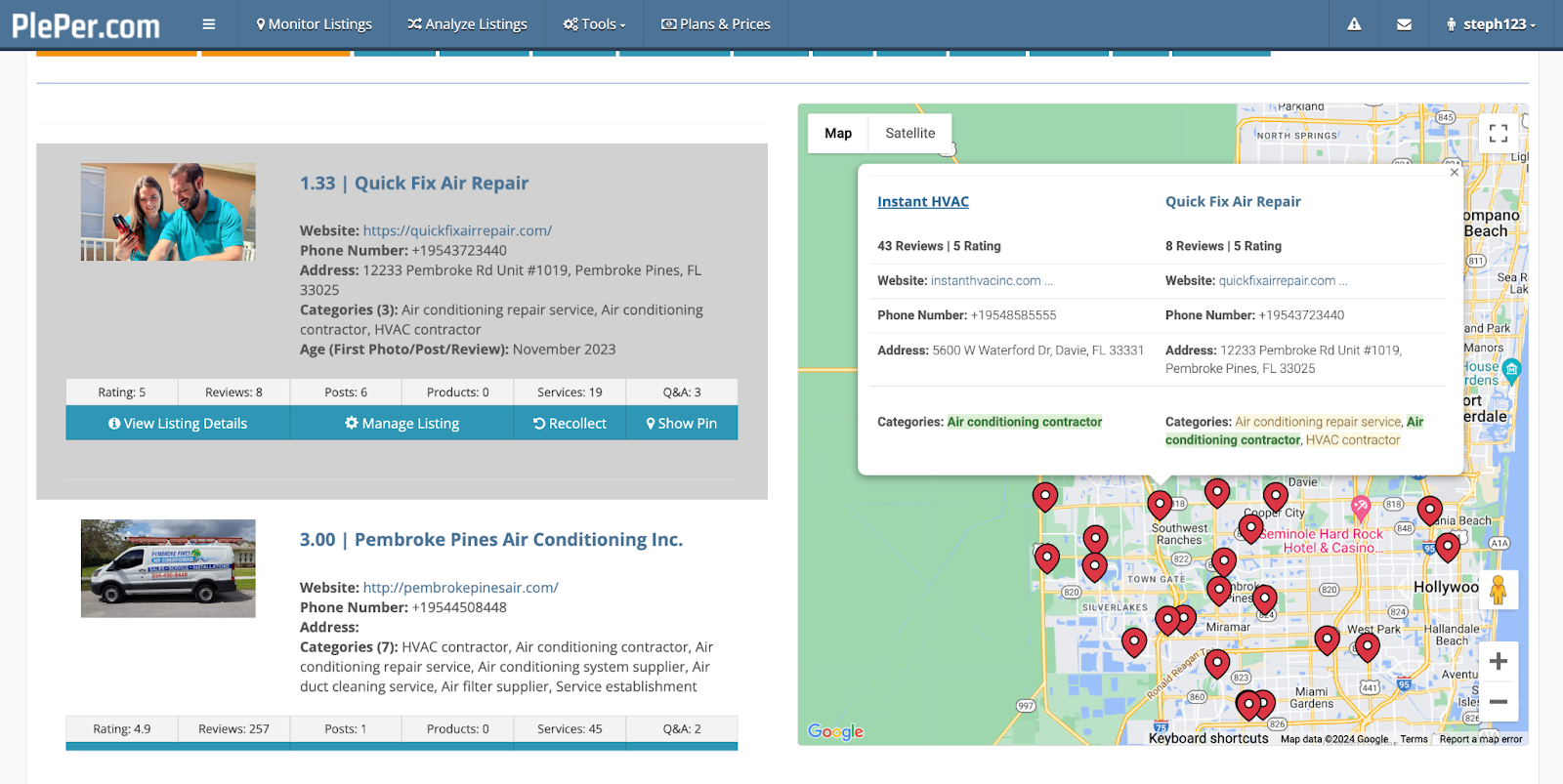
Image Source
Price: A free trial is available. Plans cost $10 a month for local pros, $25 a month for local agencies, and $150 a month for the big guys.
PlePer is a local SEO management software with tools for analyzing and managing Google Business Profiles (GBP). This SEO tool also lets you analyze your competitors’ profiles so you can use the insights to optimize your GBP account and get better local search visibility.
Here are a few things you can do with PlePer:
- Analyze competitor listing. Discover and analyze the categories of top-ranking competitors.
- Generate GBP review link. Create a link so customers can give a Google review in one click.
- Search for duplicate listings. Identify duplicate GBP listings to delete.
- Monitor your GBP. Receive updates when people review your Google Business Profile.
Now that you’ve learned about some of the best free and paid SEO tools on the market, determine which option will help you achieve your SEO goals and get started auditing, optimizing, and monitoring your website, individual web pages, and content.
Editor’s note: This post was originally published in December 2018 and has been updated for comprehensiveness.



![]()

![Download Now: 150+ Content Creation Templates [Free Kit]](https://i4lead.com/wp-content/uploads/2024/03/5478fa12-4cc3-4140-ba96-bc103eeb873e.png)
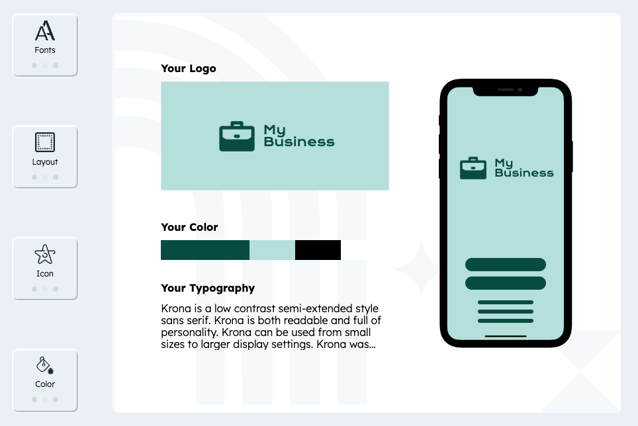

![→ Download Now: SEO Starter Pack [Free Kit]](https://i4lead.com/wp-content/uploads/2024/03/1d7211ac-7b1b-4405-b940-54b8acedb26e.png)
































![Free Ebook: The Marketer's Guide to TikTok for Business [Download Now]](https://i4lead.com/wp-content/uploads/2024/03/2c7242e4-ad54-4f63-8627-a15aa6a2ea50-1.png)
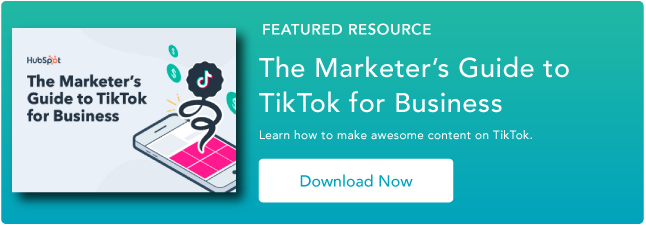
![→ Free Templates: How to Use YouTube for Business [Download Now]](https://i4lead.com/wp-content/uploads/2024/03/b33cfd44-133a-49e3-a943-086c5679d485.png)


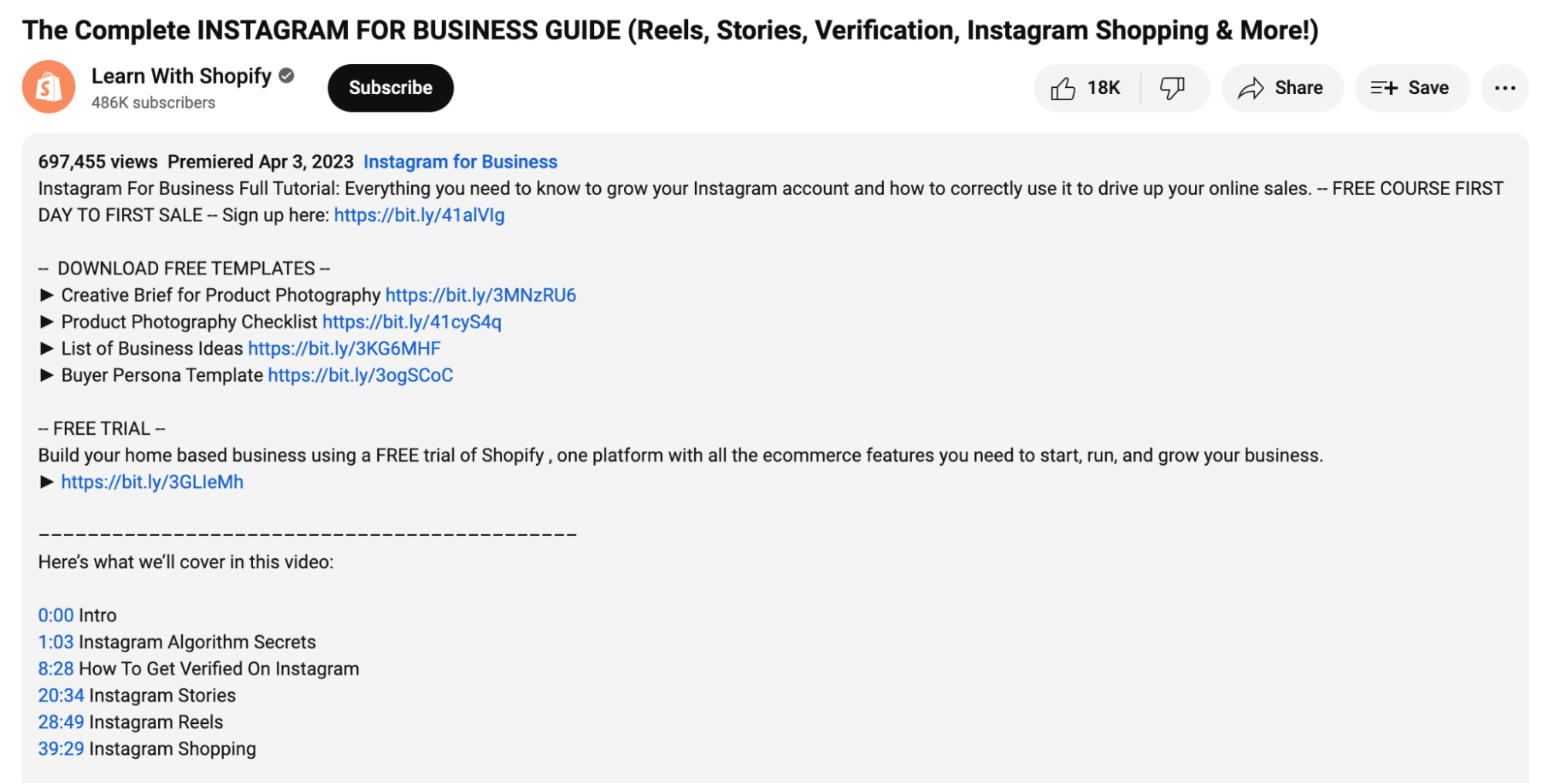
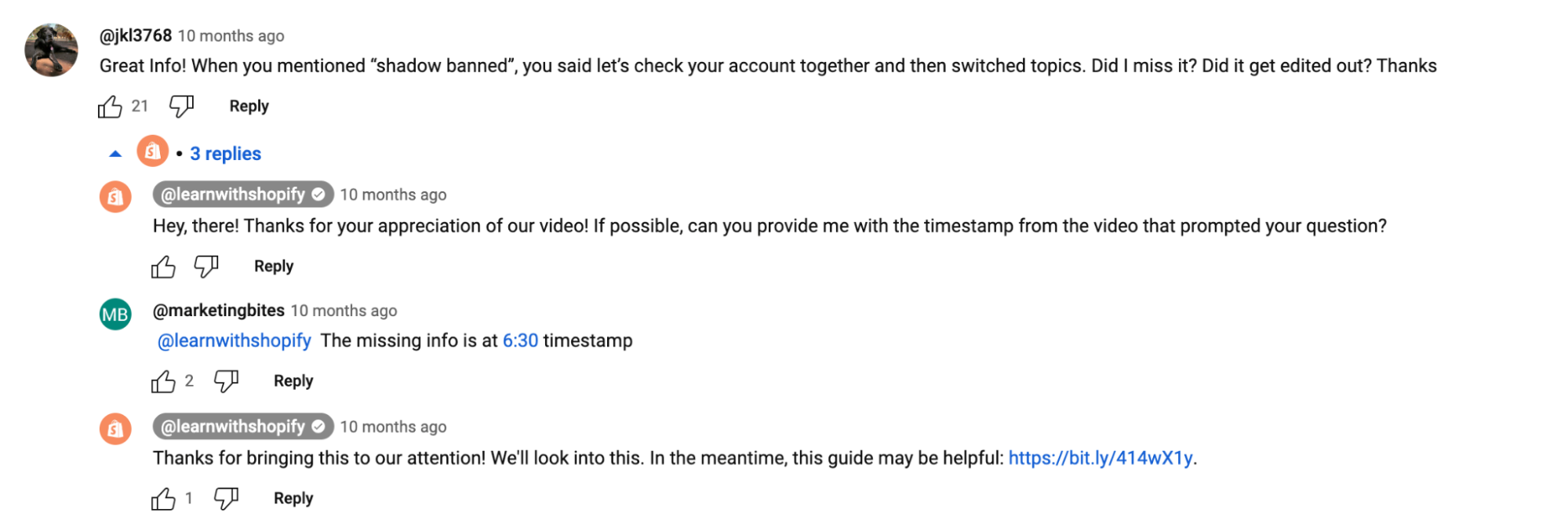


![→ Download Now: The Beginner's Guide to Email Marketing [Free Ebook]](https://i4lead.com/wp-content/uploads/2024/03/53e8428a-29a5-4225-a6ea-bca8ef991c19-3.png)

![Download Now: Free State of Marketing Report [Updated for 2024]](https://i4lead.com/wp-content/uploads/2024/03/b0f73a5e-16e4-41fd-9511-8564efc560a7-1.png)
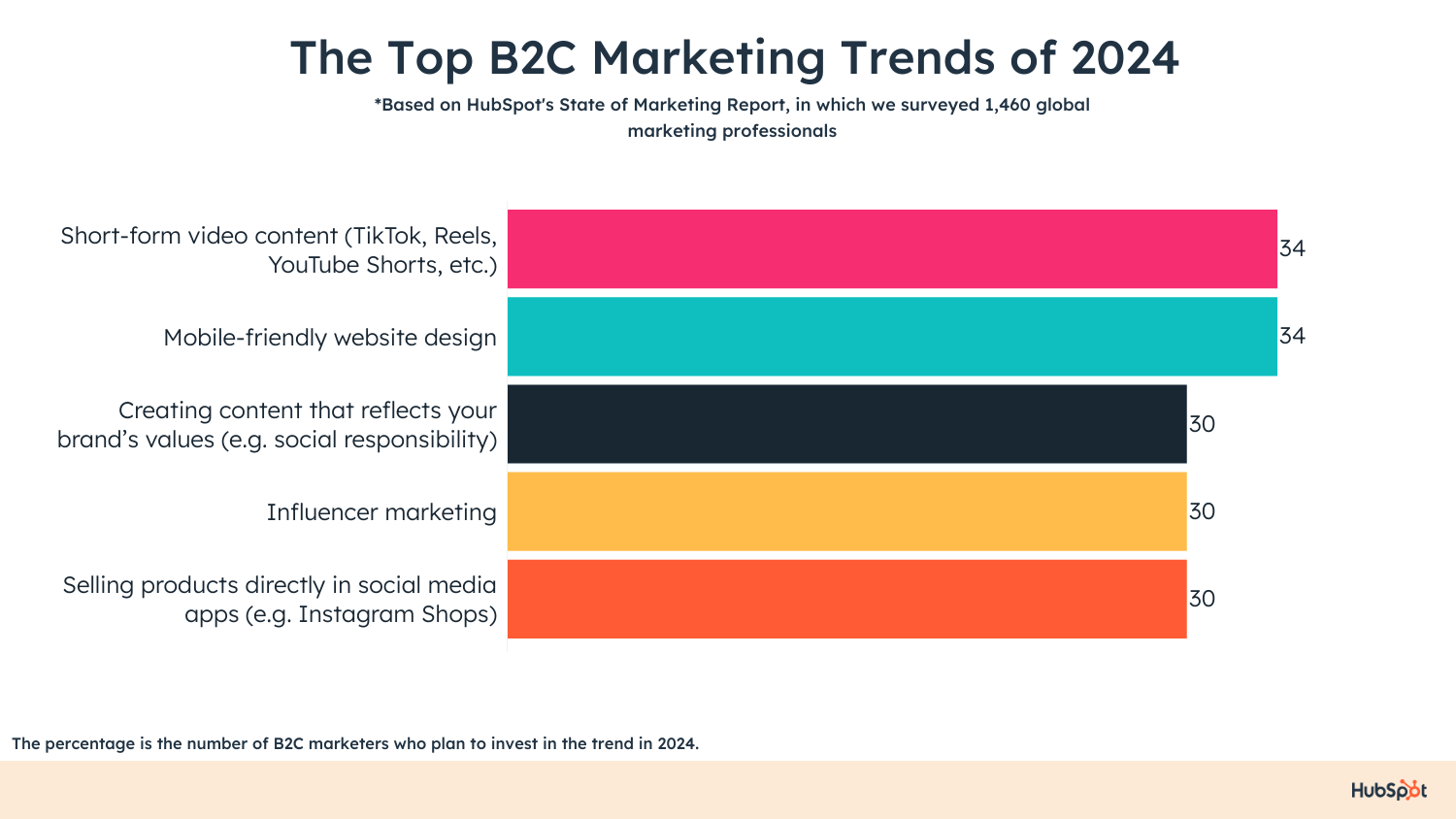


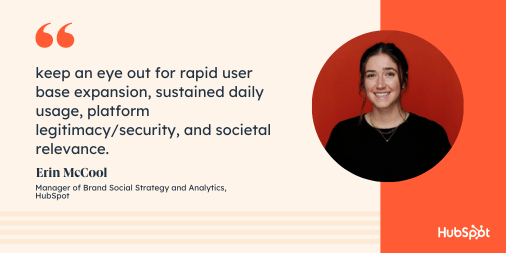
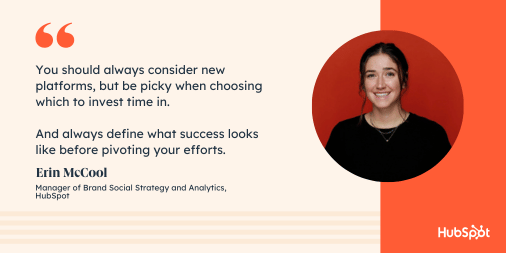

![Free Ebook: The Marketer's Guide to TikTok for Business [Download Now]](https://i4lead.com/wp-content/uploads/2024/03/2c7242e4-ad54-4f63-8627-a15aa6a2ea50.png)
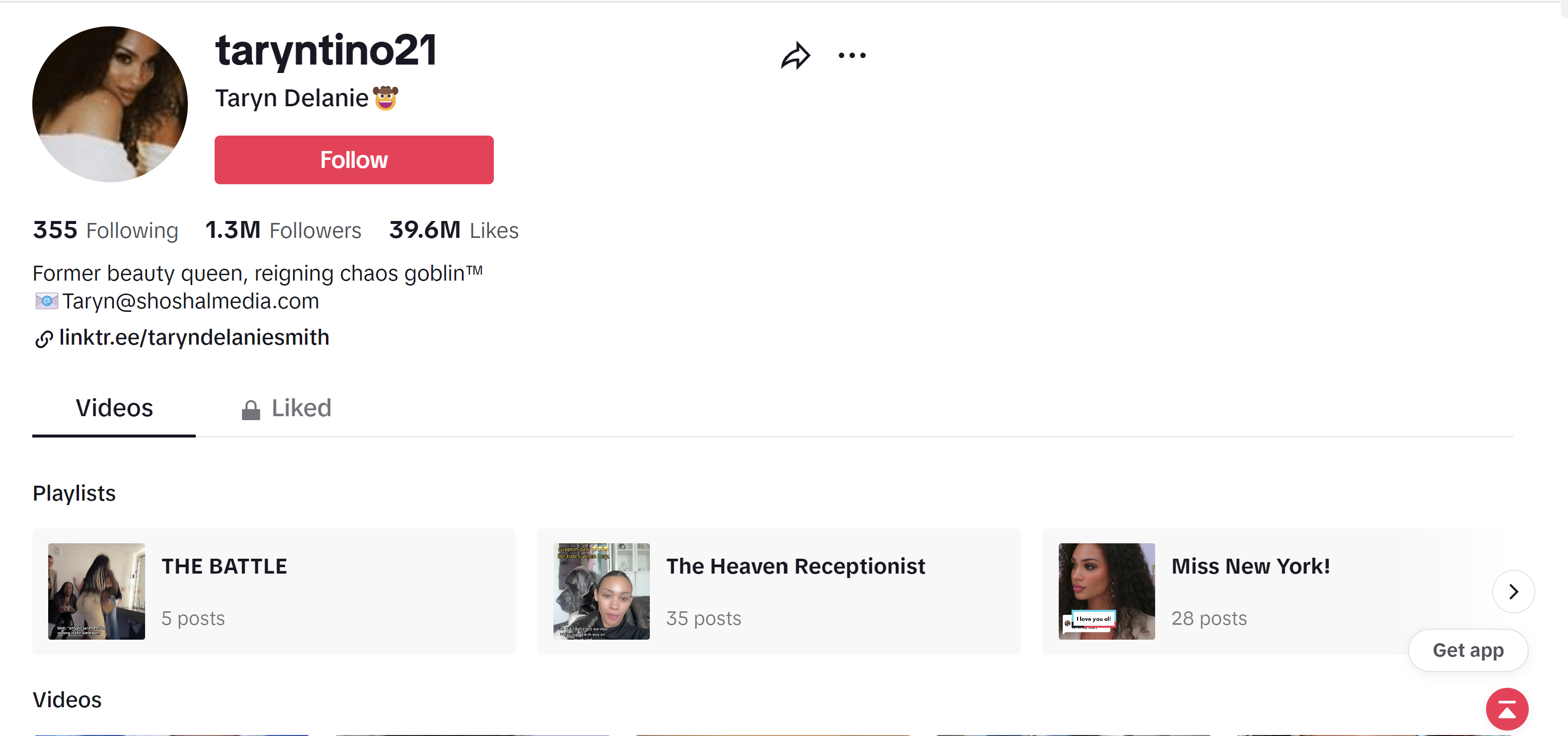

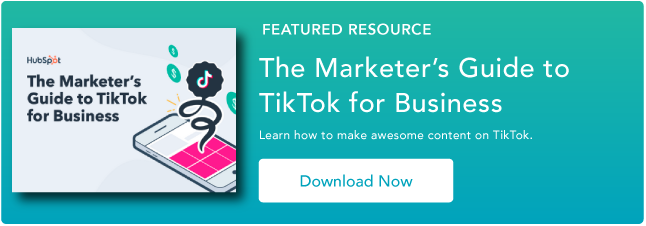
![→ Download Now: The Beginner's Guide to Email Marketing [Free Ebook]](https://i4lead.com/wp-content/uploads/2024/03/53e8428a-29a5-4225-a6ea-bca8ef991c19-2.png)
